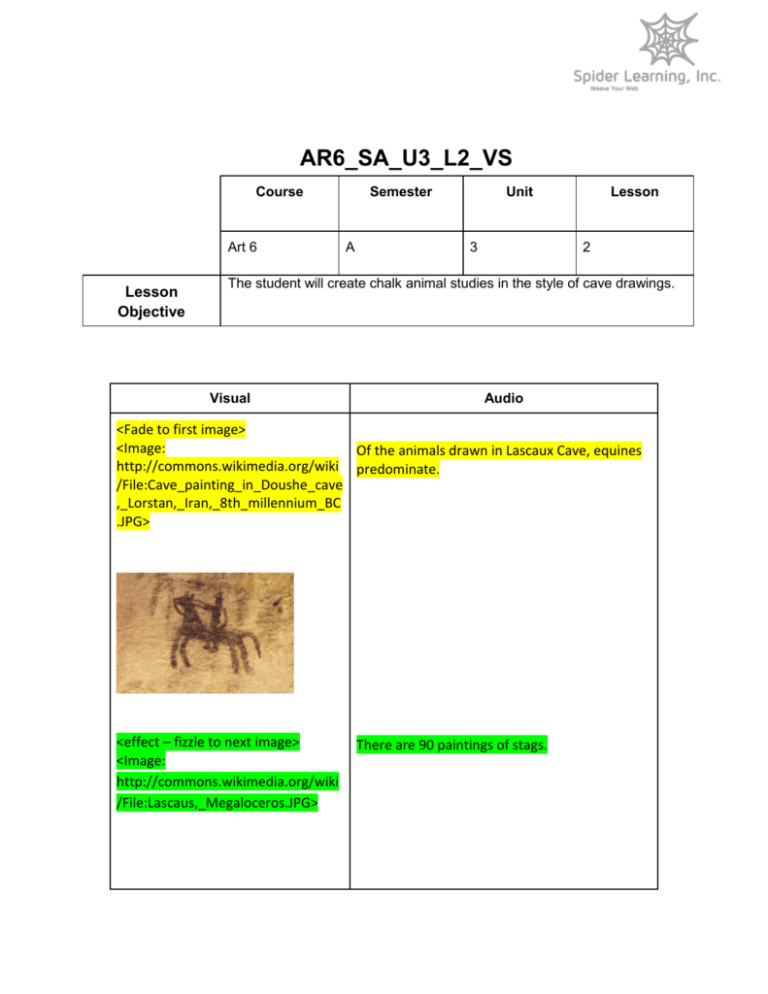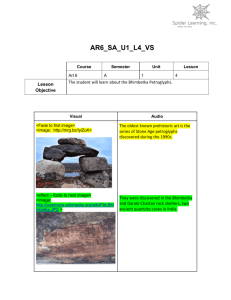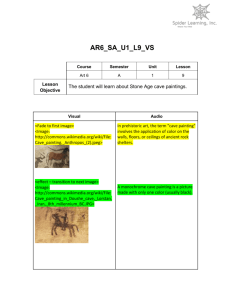AR6_SA_U3_L2_VS
advertisement

AR6_SA_U3_L2_VS Course Art 6 Lesson Objective Semester A Unit 3 Lesson 2 The student will create chalk animal studies in the style of cave drawings. Visual Audio <Fade to first image> <Image: Of the animals drawn in Lascaux Cave, equines http://commons.wikimedia.org/wiki predominate. /File:Cave_painting_in_Doushe_cave ,_Lorstan,_Iran,_8th_millennium_BC .JPG> <effect – fizzle to next image> <Image: http://commons.wikimedia.org/wiki /File:Lascaus,_Megaloceros.JPG> There are 90 paintings of stags. Also represented are cattle, bison, felines, a <effect – fade to image> bird, a bear, a rhinoceros, and a human. <Image: http://commons.wikimedia.org/wiki /File:Cave_painting,_Anthropos_(2).j peg> <effect – fade to image> <image: http://commons.wikimedia.org/wiki /File:Lascaux,_replica_05.JPG > Among the most famous images are four huge, black bulls or aurochs in the Hall of the Bulls. One of the bulls is 17 feet long - the largest animal discovered so far in cave art. <effect – fade to image> <Image: http://www.morguefile.com/archive /display/900879 > Additionally, the bulls appear to be in motion. <effect – fade to image> <Image: http://mrg.bz/2yEelu> A painting referred to as 'The Crossed Bison', found in the chamber called the Nave, is often held as an example of the skill of the Paleolithic cave painters. <effect – fade to image> <Image: http://commons.wikimedia.org/wiki /File:Lascaux-diverticule-félins.jpg> <effect – fizzle to image> <image: http://commons.wikimedia.org/wiki /File:LascauxStier.jpg> <effect – fade to image> <image: http://commons.wikimedia.org/wiki /File:Lascaux,_replica_02.JPG> The crossed hind legs show the ability to use perspective. We’ll be using that crossed hind leg strategy in our first cave drawing of a horse. <effect – fade to text, display as audio is read> <TEXT displayed in bold, bright colors text that will be the title to first section: BEGINNING YOUR HORSE> With your sketchbook paper and chalk at hand, you’re ready to begin your horse! <effect – fizzle to image> <Image: WRITERS IMAGE HORSE 1> You should begin by drawing the forehead of the horse. <effect – fizzle to image> <Image: WRITERS IMAGE HORSE 2> Next, draw the lower neck. Here, we’re using alternating colors of black and red so you can see the progress as we move along. <effect – fade to image> <Image: WRITERS IMAGE HORSE 3> The third step requires you to sketch the upper neck and lower back towards the tail. <effect – fizzle to text> <image: http://mrg.bz/AO2Wsa> As you add length to the body, make sure it is in proportion with the rest of the horse. <effect – fade to image> <Image: WRITERS IMAGE HORSE 4> Now, draw the beginning of the front legs and the rear legs. <effect – fizzle to text> <image: http://mrg.bz/iXZi97> <effect – fade to image> <Image: http://commons.wikimedia.org/wiki /File:Kapova_cave,_replica.JPG> <effect – fizzle to next image> <Image: http://mrg.bz/CFcftR> Legs can be tricky – you’ll want to be sure that they aren’t too thin and spindly or too thick and bulky. However, remember that these are cave drawings. It’s okay for there to be various textures and overlapping lines. There’s no room for perfection in cave art. It’s all about using the tools and locations available to you. <effect – fizzle to next image, display on white background> <image: http://commons.wikimedia.org/wiki /File:Cueva_de_Hornos_de_la_Peña _(grabados).png> <effect – fade to text> <TEXT: display in large, bold, brightly colored text that will be the title to first section: COMPLETING THE HORSE> <effect – fizzle to next image> <Image: WRITERS IMAGE HORSE 5> Now that you’ve established a general base for the horse, you’ll want to add to it. Start by adding a few more lines to the front and rear legs. <effect – fizzle to next image> <Image: http://mrg.bz/PNoRtd> Also, don’t forget to add the ear – it’s a pretty important feature. <effect – fizzle to next image> <image: WRITERS IMAGE HORSE 6> Next, you’ll want to finish the underbelly and the two legs and hooves. <effect – fade to image> <image: http://mrg.bz/4cuKQI> Don’t worry about adding extra detail to the hooves. A general shape is fine. <effect – fade to image> <image: http://mrg.bz/fSbw5p> Now, we’ll focus on giving the horse motion. <effect – fizzle to text> <image: WRITERS IMAGE HORSE 7> Draw the 2nd set of legs, being sure that they appear underneath the first set. <effect – fade to image> <image: WRITERS IMAGE HORSE 8> Now, finish by drawing the mane and tail to complete this drawing of the horse. <effect – fizzle to text, display on white background> <image: http://commons.wikimedia.org/wiki /File:De_nyeste_Kunstretninger_og_ smitsomme_SindslidelserVægtegning_i_Combarelles.png> Again, detail here can be basic. Consider the cave paintings of Lascaux. They were often colorful and well preserved, but not intricate in their detail. <effect – fade to text> <TEXT: display as large, bold, brightly colored text that will be the title to Now that your horse is complete, you’ll want to first section: SHADING YOUR add in some shading to give it depth and HORSE> movement. <effect – fade to image> <Image: http://mrg.bz/0D9H3N> <effect – fade to image> <Image: http://mrg.bz/yoJosH> <effect – fade to image> <Image: http://mrg.bz/jbKSm6> You should always start light and layer the color to achieve the depth that you are looking for. Remember to have a paper towel or cotton swab on hand to blur and blend any mistakes that you may make. Feel free to experiment and have fun whenever trying out a new technique. If you’ve never worked with chalk before, you should take advantage of this time to try different ways to draw with it. <effect- fade to image> <image: http://mrg.bz/hsIKOp> For example, you may want to follow the natural lines of the horse’s shape to create a multi-dimensional look. <effect- fade to image> <Image: http://mrg.bz/QDIRBI> Also, remember that chalk can smear and smudge. <effect – fade to image> When you are finished shading, give the piece a final light brushing with a clean cotton ball to remove any loose chalk. <image: http://mrg.bz/A4p9iD> <effect – fizzle to image> <image: http://mrg.bz/iC1AS4> <effect – fade to image> <image: http://mrg.bz/zrRY7M> Now that you’ve completed your horse, it’s time to move on to the next Lascaux-inspired animal: the bull!








